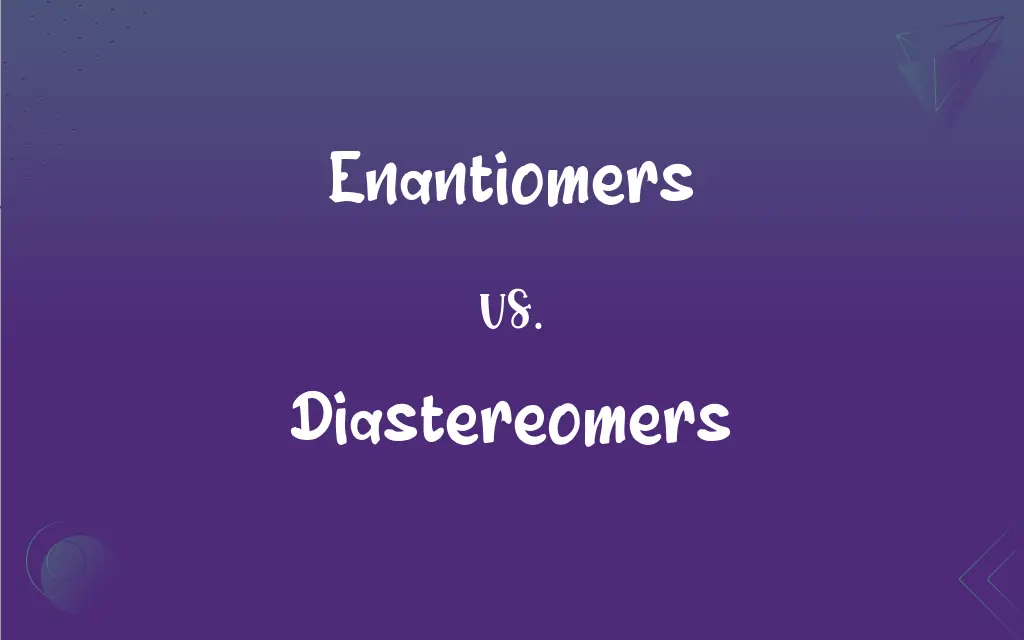Enantiomers vs. Diastereomers: What's the Difference?
Edited by Aimie Carlson || By Harlon Moss || Published on January 3, 2024
Enantiomers are mirror-image isomers that cannot be superimposed, while diastereomers are non-mirror-image isomers with different physical properties.

Key Differences
Enantiomers are chiral molecules that are mirror images of each other but cannot be superimposed. This is in contrast to diastereomers, which are also stereoisomers but not mirror images of each other. While enantiomers share many physical and chemical properties, diastereomers often have different physical properties.
Enantiomers typically differ in the way they rotate plane-polarized light, known as optical activity. Diastereomers, on the other hand, can have different melting points, boiling points, and solubilities due to their different spatial arrangements.
The biological activity of enantiomers can vary significantly; one enantiomer may be biologically active, while the other is less active or inactive. Diastereomers, because of their different physical and chemical properties, can show different biological activities.
In enantiomers, each isomer is a non-superimposable mirror image of the other. In contrast, diastereomers have two or more stereocenters and are not mirror images of each other.
Enantiomers require a chiral environment to be distinguished, whereas diastereomers can be differentiated in both chiral and achiral environments due to their distinct physical properties.
ADVERTISEMENT
Comparison Chart
Mirror Image Relation
Non-superimposable mirror images
Not mirror images
Physical Properties
Similar except for optical activity
Often differ significantly
Biological Activity
May differ, particularly in chiral environments
Often differ due to structural differences
Requirement of Stereo Centers
One stereocenter is enough
Require two or more stereocenters
Superimposability
Cannot be superimposed
Can be superimposed but differ at some stereocenters
ADVERTISEMENT
Enantiomers and Diastereomers Definitions
Enantiomers
Enantiomers occur in chiral molecules with a single stereocenter.
In organic chemistry, enantiomers are often separated using chiral chromatography.
Diastereomers
They often have different physical and chemical properties.
The diastereomers of a compound were separated due to their differing solubilities.
Enantiomers
Enantiomers are stereoisomers that are non-superimposable mirror images.
The enantiomers of lactic acid show different optical activities.
Diastereomers
These isomers can be distinguished in both chiral and achiral environments.
Diastereomers of certain drugs can be identified by their distinct spectral properties.
Enantiomers
Enantiomers are often used in pharmaceuticals where specific isomer is required.
Pharmacists must be careful when dispensing drugs that have enantiomers.
Diastereomers
Diastereomers arise from molecules with multiple stereocenters.
In sugar molecules, different diastereomers are known as epimers.
Enantiomers
They have identical physical properties except for the direction of rotation of plane-polarized light.
Enantiomers of a drug may have different effects on the body.
Diastereomers
Diastereomers are stereoisomers that are not mirror images of each other.
Diastereomers of tartaric acid have different melting points.
Enantiomers
These isomers can have vastly different biological activities.
One enantiomer of thalidomide is therapeutic, while the other is teratogenic.
Diastereomers
Diastereomers can have different biological activities and uses.
The diastereomers of a pesticide showed varying levels of effectiveness.
Enantiomers
Either of a pair of molecules that are mirror images but cannot be superimposed on each other, and that rotate the plane of polarized light by an equal amount in opposite directions. Also called enantiomorph, optical isomer.
Diastereomers
Plural of diastereomer
Enantiomers
Plural of enantiomer
FAQs
What are enantiomers?
Mirror image stereoisomers that are non-superimposable.
What are diastereomers?
Stereoisomers that are not mirror images of each other.
How do enantiomers differ in properties?
They have identical properties except for optical activity.
Can enantiomers have different effects in biology?
Yes, they can have vastly different biological activities.
Do diastereomers have different boiling points?
Yes, they often have different boiling and melting points.
Do diastereomers have different solubilities?
Often, they have differing solubilities.
Are diastereomers optically active?
Yes, they can be optically active.
How many stereocenters do diastereomers need?
They require two or more stereocenters.
Are enantiomers common in drugs?
Yes, many drugs have specific enantiomers for desired effects.
Can enantiomers be separated easily?
Separation requires specific techniques like chiral chromatography.
What is a chiral center in enantiomers?
A carbon atom bonded to four different groups.
How do diastereomers affect the taste of substances?
They can impart different tastes to substances.
Can diastereomers be separated by regular methods?
Yes, due to their different physical properties.
Are diastereomers common in sugars?
Yes, sugars often exist as diastereomers.
Do enantiomers rotate light in the same direction?
No, they rotate light in opposite directions.
Do enantiomers require a chiral environment for distinction?
Yes, their differences are apparent in chiral environments.
Can diastereomers be used in stereoselective synthesis?
Yes, they are important in stereoselective chemical synthesis.
Are diastereomers superimposable?
They can be superimposed but differ at some stereocenters.
How are enantiomers identified?
Through their ability to rotate plane-polarized light differently.
Can enantiomers be found in nature?
Yes, many natural compounds exist as enantiomers.
About Author
Written by
Harlon MossHarlon is a seasoned quality moderator and accomplished content writer for Difference Wiki. An alumnus of the prestigious University of California, he earned his degree in Computer Science. Leveraging his academic background, Harlon brings a meticulous and informed perspective to his work, ensuring content accuracy and excellence.
Edited by
Aimie CarlsonAimie Carlson, holding a master's degree in English literature, is a fervent English language enthusiast. She lends her writing talents to Difference Wiki, a prominent website that specializes in comparisons, offering readers insightful analyses that both captivate and inform.































































